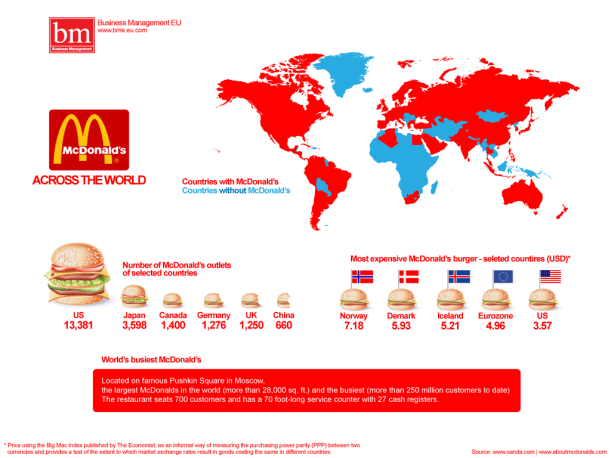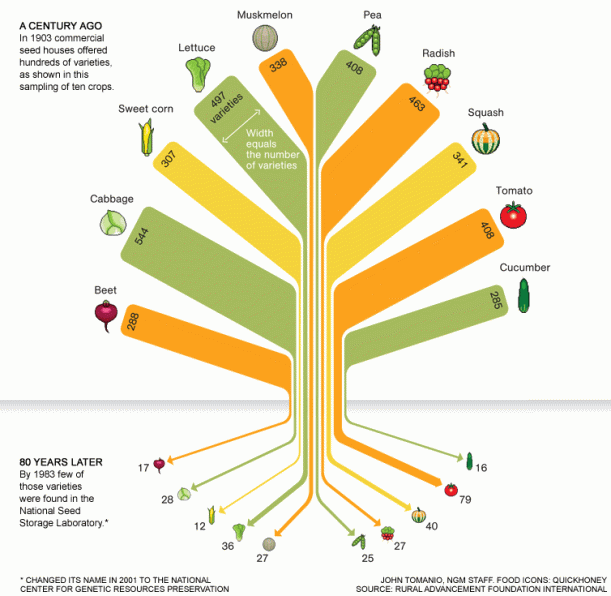A new study conducted by the CGIAR in collaboration with a whole number of universities (its title is “Increasing homogeneity in global food supplies and the implications for food security” and was published in the PNAS journal) sheds some light on the realities of whether our diets are converging as much as we think they do. Spoiler alert – they do.
Through looking at FAO data on food supply over the last 50-ish years (1961 until 2009), and comparing the supply numbers of different countries, they find that a) national per capita food supplies increased both in the amount of calories, protein, fat and weight provided and the share of calories coming from energy-dense foods; and that b) “the number of measured crop commodities contributing to national food supplies increased, the relative contribution of these commodities within these supplies became more even, and the dominance of the most significant commodities decreased“.
Funnily enough, while these two facts should read as good news – people getting more food and a greater variety of it -, on a global perspective it means that our diets are becoming more and more homogenized. Think about it – if there are more and more products entering most national diets, and evening out over time to equal shares, the previously ubiquitous product (which was radically different between different diets) is being abandoned for Western staple goods. I know, it takes a while to wrap your head around, but here is some more data:
Wheat, rice, maize, and other ubiquitous crop commodities were among those with the greatest gains in both relative and absolute abundance in national per capita food supplies over the past 50 y. In addition, the degree of increase in spread was generally a good predictor of change in the abundance of the crop commodities in food supplies. For example, oil commodities such as soybean, sunflower, palm oil, and rape and mustard were among the crops showing the greatest average increase in relative abundance in national food supplies, whereas millets, rye, sorghum, yams, cassava, and sweet potatoes showed the largest declines. (p. 2)
So while everybody is enjoying the influx of Western-style processed and high-caloric food – based on wheat, corn, and oil – other previous staple crops such as yams and millets are being left behind. This can be explained to a certain extent by the increase in average income in many countries during this time; in addition, the article points towards globalization, urbanization, trade liberalization and the development of extensive commodity transport systems, multinational food industries, food quality and safety standardization, mass media, labor changes, smaller family sizes, supermarkets, fast food, processed foods, and human migration as causes for the homogenization of what we eat. Just think of the ubiquity of McDonald’s and other fast food chains around the world.

So, is this development good or bad? The authors actually give an interestingly multifaceted perspective… On the one hand, they say that “increases in measured crop-species richness and evenness in food supplies may be considered as indicative of enhanced food security on the local level, particularly in regard to availability and access.” (p. 4) On the other hand, the shift toward more energy-dense food and processed products is also associated with a rise in prevalence of non-communicable diseases (adult-onset diabetes, heart disease, cancer, etc.), which are spreading rapidly across emerging countries as well. From a global health perspective, then, it’s a mixed bag.
But what about the environment, and the resilience of our food system? First off, they calculate the following:
50 of the measured crop commodities currently contribute to the top 90% of calories, protein, fat, and weight around the world. We estimate that these crop commodities are composed of 94 crop species from 70 genera from 37 plant families. (p. 2)
This means that the more reliant we are on these particular species, the more care we have to take that they are not affected by disease or similar catastrophes. The authors point to the importance of the breeding and cultivation of varieties of these crops with genetically diverse backgrounds in order to maintain a certain degree of biodiversity despite the concentration in crop type. However, this is the complete opposite of what is happening right now. As they say, “Though varietal diversity, particularly of major cereal crops, can in some regions be relatively high, for other key crops, such as banana, only a handful of varieties are widely cultivated, despite substantial diversity in the gene pool as a whole.” (p. 4).
This National Geographic infographic by John Tomanio shows the development very well:
If the same development is true for our major staple crops (which it seems to be), we should be truly concerned about the resilience of our food supply. As the main author of the article, Colin Khouly, says in this interview with Reuters:
“We know from history that there is vulnerability caused by uniformity in agriculture. The big examples, terrible ones of course, are the Irish potato famine and an event with corn in the U.S. in the 70s. […] I have an analogy I like to use about transport systems. Here where I live in Cali, Colombia, people take these microbuses to work, and there’s 20-30 people on a bus, and if any of those buses breaks down, it affects that many people. But if you have a system like the Tokyo metro, where you’re transporting millions of people a day and its efficient and fast and people believe in it and its working, if you have a breakdown in that system, it also affects a lot more people”.
The solution?
Produce a variety of crops, and not just a select few that seem the most profitable at the moment. Also, the conservation and continued use of a broad range of genetically varied species, as done in seed banks and exchanges, is important. Especially, seed and gene banks require more financial and institutional support in reaching out to collect more varieties and to distribute them to breeders without many resources that can continue to re-disseminate them. Basically, many points that we have heard before, but it’s good to hear them from distinguished scientists. Now, when will policy-makers actually do something about it?
Paper reference:
Khoury, C.K. et al., 2014. Increasing homogeneity in global food supplies and the implications for food security. Proceedings of the National Academy of Sciences of the United States of America, p.1313490111–. Available at: http://www.pnas.org/cgi/content/long/1313490111v1 [Accessed March 19, 2014].
